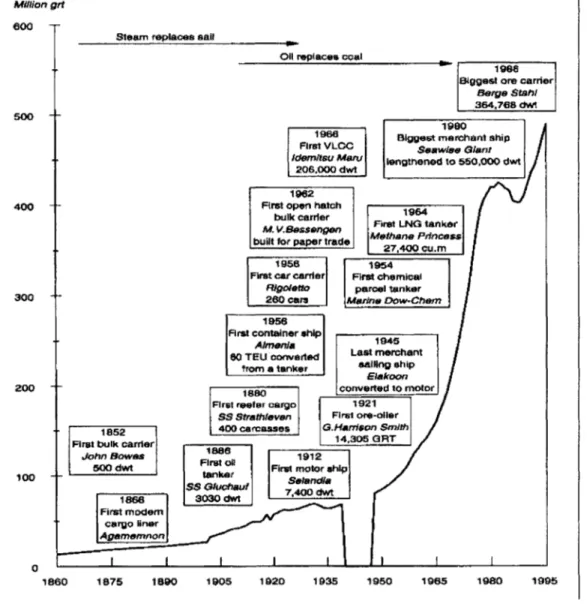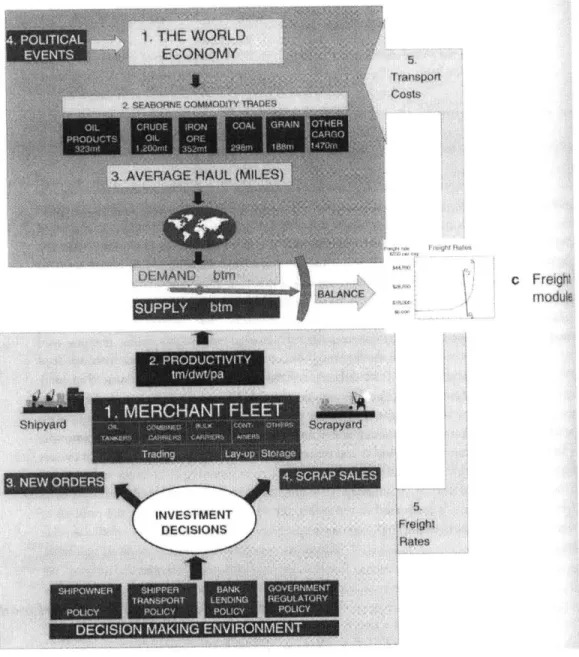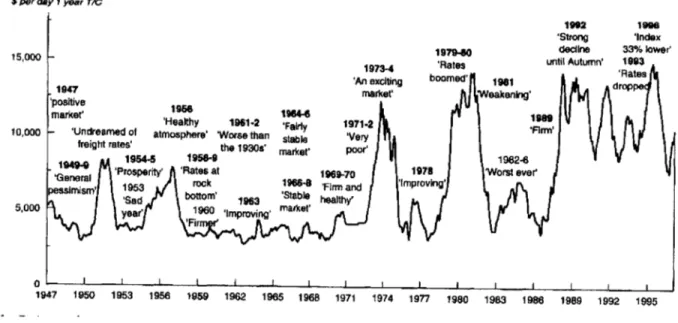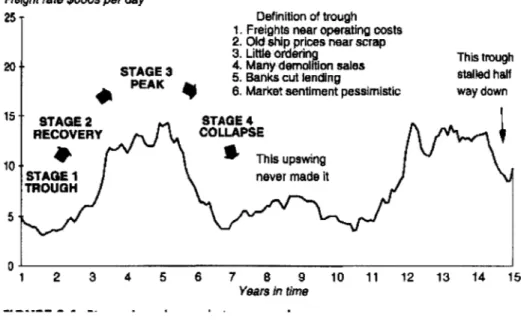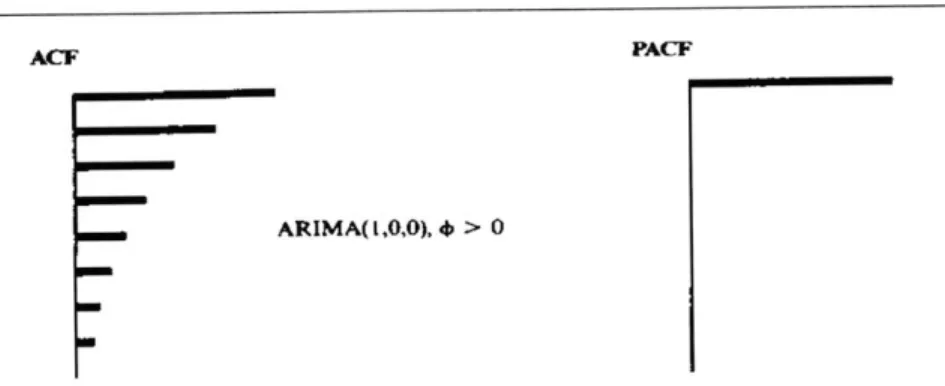ECONOMETRIC MODELING OF OCEAN FREIGHT RATES: THE CASE OF TANKERS by
DIMITRIS AYVATOGLU
B.Sc. MECHANICAL ENGINEERING - BROWN UNIVERSITY, 1999
B.A. BUSINESS ECONOMICS - BROWN UNIVERSITY, 1999
SUBMITTED TO THE DEPARTMENT OF OCEAN ENGINEERING IN PARTIAL FULFILLMENT OF THE REQUIREMENTS FOR THE DEGREE OF
MASTER OF SCIENCE IN OCEAN SYSTEMS MANAGEMENT
AT THE
MASSACHUSETTS INSTITUTE OF TECHNOLOGY
JUNE 2001
C 2001 Massachusetts Institute of Technology. All rights reserved.
The author hereby grants to MIT permission to reproduce and to distribute publicly paper and electronic copies of this thesis document in whole or in part.
Signature of Author:... Certified by:... Accepted by: MASSACHUSETTS INSTITUTE OF TECHNOLOGY
JUL 112001
.. ... ... Department of Ocean EngineeringMay 11, 2001
... Professor Henry S. Marcus Professor of Marine Systems Thesis Supervisor
... Professor Henrik Schmidt Professor of Ocean Engineering Chairman, Department Committee on Graduate Students
Econometric Modeling of Ocean Freight Rates: The Case of Tankers
byDimitris Ayvatoglu
Submitted to the Department of Ocean Engineering on May 11, 2001 in Partial Fulfillment of the Requirements for the Degree of
Master of Science in Ocean Systems Management
Abstract
The aim of this thesis is to investigate the efficiency of the tanker freight market, and at the same time illustrate shortcomings in the prevailing econometric methodology. The analysis is based on three different vessels: a product tanker, a suezmax tanker, and a VLCC tanker. The first part of the paper gives an overview of the maritime industry, focusing on the economic forces behind the cyclicality of the freight market. The second part of the paper applies the Box-Jenkins methodology to model the earnings time series of the above-mentioned vessels using an ARIMA-type model. The results show evidence against an efficient market for the product tanker, whereas they are inconclusive as far as the suezmax and VLCC tankers are concerned. The third part of the paper identifies possible shortcomings of the ARIMA class of models, as they are applied to the maritime industry. To correct for those, an R/S analysis is performed on the same earnings time series. This second approach verifies that there are inefficiencies in the product tanker freight market. Moreover, it provides evidence against an efficient VLCC freight market. On the other hand, the suezmax earnings time series is shown to be perfectly random, hence rendering this particular freight market efficient.
Thesis Supervisor: Henry S. Marcus
Biography of Author
Dimitris Ayvatoglu was born in Athens, Greece in 1976. He attended Athens College from which he received his High School Diploma in June of 1995. In September of 1995, Mr. Ayvatoglu started his undergraduate studies at Brown University of Rhode Island. He graduated in 1999 with a dual degree in Mechanical Engineering and Business Economics, with a Magna Cum Laude distinction. Mr. Ayvatoglu continued his academic career at the Massachusetts Institute of Technology. He joined the Ocean Engineering Department and concentrated in Ocean Systems Management. Mr. Ayvatoglu is expected to graduate from MIT in June of 2001 with a Master of Science degree in Ocean Systems Management.
Mr. Ayvatoglu has been following the maritime industry closely for the past several years. During the summer recessions he worked part-time in various shipping-related firms in Piraeus, Greece.
Mr. Ayvatoglu is fluent in Greek and English.
Acknowledgements
I would like to start by thanking my advisor and thesis supervisor, Dr. Henry Marcus, for his continuous support during the past two years. His enthusiastic and easygoing character was an essential ingredient of this graduate thesis. Furthermore, this thesis could not have been written without Marsoft, Inc.'s kind gesture of providing the author with the necessary data set. My sincere thanks also go to the whole Ocean Engineering faculty of MIT for their never-ending struggle for the bestowment of a better education. I would also like to thank my friends for their support, whether inside or outside the classroom. Finally, I would like to thank those who, in one way or another, have assisted me in successfully completing this project, by giving me advice and putting up with my temper through the long process of preparing this work. In particular, I would like to express my gratitude to Anastasia, Anthony, and Athina for their assistance in editing the text.
Dimitris Ayvatoglu May 11, 2001
This work is dedicated to Vassili, Irini and Gianni, who have guided me, encouraged me, inspired me and sustained me all these years. Most of all, I am grateful to them because they
Table of Contents
Abstract
...
3
Biography of Author...
5
Acknow ledgem ents... 5
Table of Contents ... 9 List of Figures... 12 List of Tables ... 13
Chapter 1
Chapter 2
Chapter 3
Chapter 4
Introduction...
15
1.1 Scope of Thesis... 161.2 Overview of Subsequent Chapters... 17
The M aritim e Industry
...
19
2.1 The Cost of Transport ... 19
2.2 The Tanker Sector... 22
2.3 Supply vs. Dem and ... 23
2.4 M arket Cycles... 26
2.4.1 Short Cycles ... 27
2.4.2 Long Cycles ... 28
2.5
Historical Overview
...
29
Literature Survey and M otivation... 31
3.1 Supply - Dem and Models ... 31
3.2 The Mean Reverting Nature of Freight Rates... 33
3.2.1 Introduction to Stochastic Variables ... 34
3.2.2 Mean Reversion... 34
3.3.3 Concerns ... 36
Tim e Series M odels ... 39
4.1
Com m on Tim e Series Features
...
40
Chapter 5
Chapter 6
Chapter 7
4.1.2 Seasonality, Conditional Heteroskedasticity, and Non-L ine a rity ... . 4 2
4.2
ARIMA Modeling of Time Series
...
43
4.2.1 The Autoregressive (AR) Model ... 43
4.2.2 The Moving Average (MA) Model ... 44
4.2.3 The Autoregressive Integrated Moving Average Model (A R IM A ) ... . 4 5
4.3
The Box - Jenkins Methodology
...
46
4.3.1 Identification ... 46
4.3.2 Estimation... 48
4 .3.3 D iagnostics ... . 49
4.3.4 Forecasting ... 49
4.3.5 AR, MA and VAR in the Literature... 50
ARIMA Modeling of the Tanker Sector
...
51
5.1
Description of Data...
51
5.2
Modeling Procedure
...
53
5 .3
R e su lts... . . 5 3
5.3.1 Product Tanker Model ... 535.3.2 Suezmax Tanker Model 1... 55
5.3.3 Suezmax Tanker Model 2... 57
5.3.4 VLCC Tanker Model 1 ... 58
5.3.5 VLCC Tanker Model 2... 60
5.4
Comments
...
61
A Non-Gaussian Approach to Modeling...63
6.1
Random W alks and Efficient Markets
...
63
6.2
R/S Analysis of the Tanker Sector... 66
6.3
Comments
...
67
Concluding Remarks...69
Appendix A - Statistical Summary of Time Series... 71
Appendix B - Product Tanker Model...75
Appendix C - Suezmax Tanker Model...81
Appendix D - VLCC Tanker Model ... 87
Appendix E - R/S Analysis ... 93
List of Figures
Figure 1 - Fleet Innovations 1860-1995 ... 20
Figure 2 - Transport cost of oil and coal 1947-95 ... 21
Figure 3 - Average size of tankers 1900-1997 ... 21
Figure 4 - The shipping market model ... 25
Figure 5 - Single voyage tanker rates 1947-1997 ... 26
Figure 6 - The short shipping cycle ... 28
Figure 7 - A generalized Wiener process ... 35
Figure 8 - Mean reversion at different speeds r ... 35
Figure 9 - Deterministic and stochastic trends ... 41
Figure 10 - Realizations of an AR(1) process with different (p1 ... 44
Figure 11 - Realizations of a MA(1) process with different 01 ... .. .. .. ... . . 45
Figure 12 - ACF and PACF of an ARIMA(1,0,0) process ... 47
Figure 13 - ACF and PACF of a ARIMA(0,0,1) process ... 48
Figure 14 - ACF of a non-stationary time series ... 48
Figure 15 - Daily Earnings for product, suezmax and VLCC tankers ... 52
Figure 16 - Forecast for product tanker using ARIMA(3,0,0) ... 55
Figure 17 - Forecast for suezmax tanker using ARIMA(1,0,0) ... 57
Figure 18 - Forecast for suezmax tanker using ARIMA(0,1,0) ... 58
Figure 19 - Forecast for VLCC tanker using ARIMA(1,0,0) ... 60
List of Tables
Table 1- Statistical characteristics of product, suezmax and VLCC tanker earnings .. 52
Table 2 - Augmented Dickey-Fuller test for unit roots ... 54
Table 3 - Product tanker ARIMA(3,0,0) model ... 54
Table 4 - Augmented Dickey-Fuller test for unit roots ... 56
Table 5 - Augmented Dickey-Fuller test for unit roots ... 56
Table 6 - Suezmax tanker ARIMA(1,0,0) model ... 56
Table 7 - Augmented Dickey-Fuller test for unit roots ... 59
Table 8 - Augmented Dickey-Fuller test for unit roots ... 59
Table 9 - VLCC tanker ARIMA(1,0,0) model ... 59
Chapter 1
Introduction
The times when people looked at the future as simply being at the whim of God do not belong to the distant past. On the contrary, the notion of risk management owes its roots to people like Bernoulli, Fermat, Fibonacci, Pascal, Poincare, Cardano, and others who lived no more than five hundred years ago. It might seem surprising that the problem of dealing with future uncertainty was not addressed by ancient civilizations such as the Egyptians or the Greeks; civilizations that were troubled with far more challenging ideas, such as the establishment of the scientific proof through the mastery of logic. However, this last sentence almost perfectly describes the Greeks' nemesis in dealing with probability. Aristotle declared that a "mathematician who argues from probabilities in geometry is not worth an ace" (1). However, that does not imply that games whose roots were purely probabilistic were not common in the ancient world. Nevertheless, their outcomes were simply recorded and not studied, something that could mainly be attributed to the difficult-to-handle numbering system that prevailed.
The introduction of the Arabic numbering system enabled enlightened minds to dig through records of games, as well as real-life incidents, and discover shared patterns. The applications have varied from the prediction of the outcome of throwing a die to the likelihood that a man of a certain age will die within the next number of years. It is most often the case that new theories are developed in light of a potential economic gain. In the case of probability theory, the driving force was insurance policies. Although the companies engaged in this field initially failed to recognize the importance of sampling so as to get a sense of the probable future outcomes, academics have dealt with the problem extensively.
Probability and shipping merged in a very early stage in the game. The coffeehouse that Edward Lloyd opened in 1687 near the Thames River became the favorite place for ship operators and shippers. It served much like a contemporary brokerage house, where people would get together and arrange for the transportation of goods. Each transaction was recorded and was followed until either delivery took or an accident took place. This provided the perfect framework under
which shipping insurance would be developed. Interesting for us is not so much the development of the shipping insurance industry, but rather the probabilistic approach undertaken by insurance companies to evaluate the risk of insuring a certain cargo going on a certain route, based on past accident records for that particular route. Nevertheless, the decision-making tools in this industry failed to keep up with the pace. Although the industry adopted the relatively simple discounting rules for analyzing projects, it failed to follow recent developments in time series analyses, such as unit root tests, cointegration, GARCH, non-linearity, seasonality, and others (2)
This became evident in the late 1980s and '90s, when these new technologies ceased to be abstract academic formulations and were successfully adopted by different markets around the world.
1.1
Scope of Thesis
Statistics, and later on econometrics, emerged from the solid foundations that probability theory had already established. Statistics is defined as "a branch of mathematics dealing with the collection, analysis, interpretation, and presentation of masses of numerical data" (3). The application of mathematical statistics to economic data with a goal of providing empirical support to models constructed by mathematical economics later gave rise to the field of econometrics. Time series analysis, as employed in the context of econometric analysis, is concerned with the detection of non-random (4) patterns in a sequence of measurements of
economic variables observed over time
The variety of available time series models will be discussed in Chapter 4. However, due to time and size limitations, this work will mainly focus on the application of univariate time series analysis and more specifically on the autoregressive integrated moving average (ARIMA) methodology. The variable under examination will be a variant of freight rates, namely the 'rent' that a ship owner earns in exchange for providing transportation services. The area of shipping
2 These statistical notions are extensively discussed in Chapter 4
3 Wackerly et al (1996), p.1
4 The topic of how one should define randomness is extensively discussed in Chapter 6
that will be investigated using the proposed methodology will be the tanker sector and more specifically 40,000 dwt (6) product carriers, suezmax and VLCC crude oil carriers.
The aim of this thesis is to test whether the ARIMA class of models can accurately depict patterns that emerge in freight rate time series. If this is shown to be true, then the theory that states that the shipping market is efficient (7) - in the sense of the Efficient Market Hypothesis
(EMH) -will be questioned. This could have significant implications for everyone involved in the shipping industry, since the relatively simple ARIMA methodology could then be used for
hedging and/or speculative purposes.
1.2
Overview of Subsequent Chapters
Chapter 2 serves as a general introduction to the maritime industry. It presents a brief history of events from the early 1880's until the late 1990's. Although the belief that history repeats itself is very popular among hoi polloi, academics most often tend to discard it as unscientific. However, the intuition that can be gained from studying past events is, in the view of the author, invaluable. Hence, a relatively extensive presentation of the market cycles and the micro- and macro-economic forces that have been affecting the seaborne shipping sector will be given.
Chapter 3 summarizes the literature on econometric modeling of vital shipping variables. Both univariate and multivariate models are presented, as well as a generic approach to stochastic processes.
Chapter 4 presents the theoretical framework on which the proposed ARIMA model is built. The pros and cons of univariate versus multivariate analysis are explained. Issues such as stationarity, heteroskedasticity, trends, non-linearity, and seasonality of time series are also discussed. Finally, the seminal work by Box and Jenkins on the methodology of model building for autoregressive models is laid out in some detail.
Chapter 5 starts by describing the data set used to test the author's hypothesis that shipping freight rates follow an ARIMA-type process. It goes on by explaining how a specific ARIMA model that is intended to fit the data is identified, estimated, diagnosed, and eventually used for forecasting purposes. The results of the model will show whether the theory of J.J. Evans on the efficiency of the shipping market is valid and to what extent forecasting is possible.
Chapter 6 discusses the major shortcomings of conventional econometric modeling. It then introduces a newly developed theory for analyzing time series data. This theory was built upon the pioneering work of H.E. Hurst on biased random walks, and Benoit Mandelbrot on fractal time series. A simple example of rescaled range analysis (R/S analysis) will be presented, as it relates to the shipping industry. The methods presented in this chapter should serve as a guide for further research in maritime time series, as they appear to be very useful in identifying non-periodic cycles, a phenomenon vividly present in the shipping market.
Chapter 7 provides the reader with concluding remarks and suggestions for further research, including extensions to conventional univariate modeling, vector autoregressive models (VAR) and R/S analysis.
Chapter 2
The Maritime Industry
Efficient sea transportation was made possible by the technologies developed during and after the Industrial Revolution. Since then, the maritime industry has played a central role in the transformation of the national systems that existed in the 1 9th century into the single global
economy of the late 2 0th century. However, the contribution of seaborne transport to the world
economy should not be viewed as a one-way transaction; to the contrary, these two entities evolved together. As nations realized the benefits of extensive trade, ships were given a prime role in the new status quo, enabling ship owners to benefit from the explosive trends in trade patterns and, in turn, further facilitate the movement of cargo over long distances at surprisingly
low prices.
2.1
The Cost of Transport
The low cost of sea transport has been one of the main factors behind the evolution of the shipping industry. This has been made possible by continuous technical revolutions (Figure 1) that have enabled ship owners to keep their costs at very low levels and hence offer their services to shippers at acceptable prices. It is worth noting that the cost of transporting a barrel of oil in the 1960s was approximately 50 cents, while in the 1990s it has averaged to about $1 (Figure 2). To put this into perspective, one has to consider that the price of crude oil averaged only $3 in 1960, with a ten-fold increase over the same number of years. The only transportation sector that has managed to keep costs from increasing throughout its history is the airline industry, constituting one reason why the shipping industry has failed to capture the long haul passenger transport business. However, in absolute terms, airborne fares are high compared to seaborne ones, hence limiting the use of airfreight to urgent or high value cargo.
From ancient times, ship captains relied on muscle power or wind to propel their ships and on their navigation instincts to find their way. With the advent of the Industrial Revolution, things changed drastically. Steam power was introduced and eventually the radio was invented, allowing for more efficient ships to be built. With the passage of time, breakthroughs in materials science and thermodynamics allowed ships to be built with steel and be fitted with
internal combustion engines, further increasing their capacity (Figure 3) and range. The next big step in the evolution of the shipping industry was the introduction of specialized vessels in the market. Given an adequate demand for the transportation of a certain type of cargo, a specialized vessel was economically viable, allowing for more efficient loading/unloading and stowage of
cargo (8). This was vital for keeping freight rates low at times when demand for sea transportation
was increasing by leaps and bounds.
Million grt 600
Steam replaces sail
Oil replaces coal
Biggest ore carrier
Berge Stahl
364.768 dwl
S00
1980
1966 Biggest merchant ship
First VLCC Seawlse Giant
ldemitsu Mom lengthened to 550.000 dwt
2600dwt_
1962
400 First open hatch 1964
bulk carrier First LNG tanker bM. V.essengen Methane Pfincess built for paper trade 27.400 cu.m
1956 1954
First car carrier First chemical
Rigoletto parcel tanker
300 260 cars Marine Dow-Chem
1956
First container ship 1945
Almenla
60 TEU conveted Last merchant from a tanker saling ship
Elakoon
200 1880 converted to motor
First reefer cargo 1921
SS Strathleven First ore-oiler
1852 400 carcasses G.Harrison Smith
First bulk carrier 14,305 GRT
John Bowas First oil1912
500 dwt tnr First motor ship
100 -ank-r Selardla SS Gluchaut 7.400 *e 1866 3030 dwt First modem cargo liner Agamemnon 0 J 1860 1875 1890 1905 1920 1935 1950 1965 1980 1995
Figure 1 -Fleet Innovations 1860-1995 9
8 Before the introduction of the tanker, oil was transported in barrels by general cargo ships, leading to decreased
stowage and increased weight. 9 Stopford (1997), p.2 0
Ol $ per barrel Coal $ per tonne 2.5 30 Cost of oH transport Cost of coal 2
/.transport
25 1,5 - -20 11 A a10 Ito 11 0.5 5 0 0 LO > 7- r -Vr 7 r M- M q- rFigure 2 -Transport cost of oil and coal 1947-95 10
Average Wtee of tanker (000 Dt)
120
The average size of tudkeremained below 20,000 wt 1977 1980
until 1960 when the closure ol the Suez Canal in 1956 FWeM GtdaureI Im wMs in4
ind grwing .1pnese oil imports triggered an escalation M4265 dwI 1000006d 10
100 in sin to orMOM dt. The average size peaked 1968 555,843 dw_
in 1980 and Ihen remained r*lalivaly stable.
80 miryMAiid
206,106 d5
1959
!raquois & Nuvahos Unverse Apo
60 Tank barge wyotem of 122.867 dwrt
17,000 tons (it rmde 148 1953
Alanic crossing) Tin Onamis
1901 119M dw
40 Slaing tanker O . 1950
3,765 G T ,0 d 1943
20 Naansl
Z
E T2 lanker 16,467_UwIEsso0
1900 1911 1922 1933 1944 1953 1964 1975 1986 1997
Figure 3 -Average size of tankers 1900-1997 "
' Ibid, p5
2.2
The Tanker Sector
In 1995, the tanker sector accounted for approximately 30% of the gross tonnage available for sea transportation. At the same time, crude oil and its products constituted more than 40% of the total tonnage shipped around the world, with the majority originating from the OPEC countries going to Western Europe, the USA and Japan. The average yearly haul of oil during the 1980s and 90s has been fairly constant to around 5,000 miles. However, this has not always been the case. After the Suez Canal had been closed in 1967, the average haul rose to more than 7,000 miles, decreasing the effective supply of ton-miles (12) and hence dramatically increasing freight
rates to the benefit of the ship owner. The immediate reaction of the shipping community was to engage in a shipbuilding rush, in view of expectations that the canal would remain closed for a considerable amount of time. However, the combination of the canal's re-opening with the delivery of the newly built vessels led to a dramatic downfall of freight rates. The downfall was further amplified in 1973 with the decision of OPEC to implement the well-known Arab Oil Embargo, decreasing long-haul demand.
It is evident by the events described above that the maritime industry is closely related to political events. After all, oil is a valuable strategic commodity that is mainly produced by only a limited number of nations, which hold similar political views. These nations use oil production as a means to make their political statements heard around the world. Fortunately, during the past year, OPEC itself committed to keeping the oil price at around $30 per barrel, giving assurances the levels of production. This has positively affected tanker owners, who can plan their newbuilding and scrapping policies on relatively safe assumptions about future prospects.
The 1973 Arab Oil Embargo had another significant impact on the transport policy of oil. Up until then, the major oil companies controlled the sea transport of oil by either holding a self-owned fleet or by engaging in long-term time charters. Consequently, such a highly structured environment minimized the spot market effect, which is widely known to be a major source of
12 Although intuitively it makes more sense to measure cargo-carrying capacity in tons, the "ton-mile" is a more
volatility. However, after 1973 the oil companies, faced with uncertainty over trade volume, started relying more heavily on the spot market, causing a wide market fragmentation to occur. It is worth mentioning that the spot market's share rose from 10% before 1973 to around 50% in
the 1990s (.
2.3
Supply vs. Demand
From the viewpoint of the shipper, the ship owner provides a service that needs to be reliable, safe, and speedy, as well as offered at a competitive price. However, the reader should not be tricked into believing that the ship owner has the power to set the price for the provided service, namely the freight rate. On the contrary, the shipping market is a very good example of perfect competition where the ship owner is a price taker. On the other hand, it should be noted that for most cargoes the cost of transportation is a very small fraction of the cost of the production and hence, the equilibrium freight rate is most often set at the inelastic region of the demand function. In the past, ship owners, being aware of that latter fact, have tried to set prices by forming organizations (14) where they pool their ships together and act as a monopoly. However,
prospective speculators who obtain market share by undercutting prices have easily undermined the effrorts of these artificial monopolies. After all, there are almost non-existent barriers to entry, apart from the need of a substantial initial investment. Consequently, pooling has only been successful in manipulating freight rates for specialized cargoes and routes and only for a limited period of time.
In general, the ship owner does not make all of his profit by operating his vessels. Instead, enormous fortunes have been made in the sales and purchase market (S&P market). This is made possible by the nature of the shipping market, which inherently moves in cycles and therefore makes it theoretically possible to buy low and sell high. However, playing the cycles is not only
suddenly decided to sail at half their current operating speed. In other words, ton-miles do not require us to make any assumptions as to the efficiency with which the fleet operates.
13 Stopford (1997), p.12 4
a matter of accurate prediction, but also of encountering another player with the opposite beliefs. In general, consensus about market movements does not create profit opportunities.
A theoretical approach to understanding market cycles is the equilibrium supply and demand model. On the one hand, the world economy, the average haul, political stability, and transport costs affect demand, while fleet productivity, shipbuilding production, and tonnage retirement affect supply. The way that these variables equilibrate themselves is through the freight rate market, as shown in Figure 4. For instance, when ships are in short supply, freight rates move higher and ship owners order ships. When these ships are delivered, freight rates depress, leading to increased lay up and scrapping, causing the supply of vessels to decrease and freight rates to increase once again. However, this process is not instantaneous, especially due to the time lag between the placement of the order and the delivery, which usually takes between 18 and 24 months. As a result, the market cycle amplitude is magnified.
The supply of vessels is determined by the interplay between four shipping markets: the newbuilding market, the freight market, the S&P market, and the scrap market. During a market trough, the newbuilding market stagnates and the scrap market flourishes. The least efficient vessels are laid up or scrapped and the rest of the fleet slow steams. At the other end of the spectrum, when the market is at its peak, the newbuilding market is most active, while the scrap market eases. All ships are operational and running at full speed. Under such conditions, the mismatch in supply and demand can only be settled in the long run, when the newly built vessels are delivered. The S&P market is usually active during both times, energized by speculators who play their game of seeking fast profit. A peculiarity of the shipping industry is that often expectations will appear to be ex post rational while in reality they are irrational. In other words, "tankship markets influence the actual price to the extent that it confirms their expectations" (.
Ultimately, what happens tomorrow depends on today.
c Freight
nodul
Figure 4 - The shipping market model 16
There is little to be said about the demand side. It is usually viewed as an exogenous variable with many non-linear effects taking place. Under normal circumstances, the demand for sea transport, and in particular for oil, exhibits inelastic characteristics and hence is slightly affected by movements in the freight rates, especially in the short run. In other words, most of the
imbalance is settled within the boundaries of the supply of vessels, as discussed above.
2.4
Market Cycles
If one undertakes the simple task of plotting freight rates since the turn of the century, it will immediatly become evident that a cyclical pattern dominates all other trends (Figure 5). To an outsider, this could suggest that fluctuations in the shipping market could be partially predicted. However, a closer look would reveal that the peaks and troughs occur at non-periodic times. To make matters even worse, simple econometric analyses that test for mean reverting patterns (17) in
freight rates yield contradictory results, depending on the time frame and route examined. Consequently, people who are entrusted with the Herculean task of forecasting the shipping markets are caught between the Scylla of shipowners who demand the development of an accurate model, and the Charybdis of randomness. Nevertheless, a recent approach to tackling randomness in the financial markets has shown promising signs. The theory of R/S analysis is by no means new, as it was developed in the early 2 0th century by a hydrologist by the name of
Hurst. However, there are no previous studies on the application of R/S analysis to the maritime industry, to the extent of the author's knowledge, and thus this project will try to motivate new research, rather than complement existent ones.
$ per day 1 year T/C
1992 1996
'Strong 'Index
15,000 -1979-80 decline 33% lower'
1973-4 'Rates until Autumn' 1993
'An exciting boomed' 1961 Rates
po1 market' Weakening' rop
market' 'Heathy 1961-2 Fa 197y-19919
10,000 - 'Undreamed Of atmosphere' 'Worse than stab 'Very
freight rates' the 1930s' market' poor'
1954-5 1958-9 1982-6
General 'Prosperity' 'Rates at 1969-70 1978 Worst ever'
pessimism' 1953 rock 1966-8 'Firm and 'Improving'
'Sad botom' 1963 'Stable healthy' 5,000 year' 1960 'Imprv maAkt'
1947 1950 1953 1956 1959 1962 1965 1968 1971 1974 1977 1980 1983 1986 1989 1992 1995
Figure 5 - 1 year T/C tanker rates 1947-1997 i
17 The notion of mean reversion will be discussed in Chapter 3 18 Stopford (1997), p.5 9
2.4.1 Short Cycles
As trade became a dominant force in the development of national economies, people identified the shipping industry as a potential source of high profits. Shipping being an international business, was faced with very few regulatory restrictions, making it a perfectly competitive market. As a result, during high profitable times, speculators would enter the market, forcing rates to decrease. Rates would rarely stabilize at their equilibrium point, however, as crowd sentiment would dominate and lead to oversupply, causing ships to eventually be run at a loss. Nevertheless, even the downturn of a cycle has its purpose as it drives the least efficient
operators out of the market, allowing for an eventual recovery.
Dr. Martin Stopford has identified the stages of a cycle in a very illustrative graph, which is presented below (Figure 6). At stage one, freight rates are low, leading ship owners to operate at a loss. Short of cash, ship owners are forced either to lay-up or scrap their vessels. As the supply of ships drops, freight rates increase and the market enters stage two. Market sentiment still remains uncertain as to whether a full-blown recovery will develop. As freight rates climb even higher, optimism spreads and ships return to the market from their laid-up status. More significantly, orders for newbuildings are placed, which often exceed what the market can absorb in the long run. Consequently, when these ships start being delivered, supply once again exceeds demand and freight rates drop, leading the market to enter stage four. At this point it should be evident that the freight and S&P markets are in complete phase with each other, while both of them are 180 degrees out of phase with the scrap market. Finally, the growth rate of the fleet, which reflects the difference between shipbuilding and scrapping, also moves periodically, but tends to lag behind rates.
The dynamics described above are present in almost all short cycles. However, the story does not end here. To the shipowner's despair, there are other factors that magnify the amplitude and length of those cycles. For instance, a war, an embargo or a sudden increase in the price of oil by OPEC would lead to a significant increase in uncertainty, which in market terms translates into increased volatility and hence higher risk. Accordingly, the ship owner should always keep in
mind that he is not alone in this game and therefore he should prudently plan his actions, considering that there are hundreds of other ship operators going after the same source of profit.
Freight rate $000s per day
25 Definition of trough
1. Freights near operating costs
2. Old sNp prices near scrap
3. Little ordering This trough
20 4. Many demolition sales stlld half
STAG 5. Banks cut lending
PEA 6. Market sentiment pessimistic way down
15 - STAGE 2 STAGE 4
RECOVERY COLLAPSE
10A This upswing
ST AGE 1 never made it
TROUGH
5 0
1 2 3 4 5 6 7 8 9 10 11 12 13 14 15
Years in time
Figure 6 -The short shipping cycle 19
2.4.2 Long Cycles
In contrast to short cycles, long cycles have much less effect on the everyday operations of a shipping firm, if any at all. However, cumulatively, their presence has been shown to have a significant effect on the industry as a whole. Kondratieff identified three periods of expansion and contraction in the world's economic activity between 1790 and 1916 (0). It has been argued that Kondratieff's cycles have coincided with periods of technological innovation, such as the harnessing of steam, the railway boom, and the invention of electricity. In recent years, important technological innovations that could support Kondratieff's theory are the development of the chemical industry, the introduction of the aircraft as a cost-effective means of travel, and the telecommunications revolution.
19 Ibid, p.43
2.5
Historical Overview
The first shipment of oil via a sea route was in 1861. Since then, the tanker sector has come a long way. However, in understanding current market affairs, one has to first study the history of oil transport. A logical division of epochs would consist of three periods. The pre-World War I era, the interwar period and the post-World War II period. The two major landmarks between 1861 and 1913 were the introduction of the steam engine and the opening of the Suez Canal to tankers. Oil trade was sluggish at the beginning, as coal was the dominant source of power. However, the efficiencies associated with the production of energy from oil, transformed oil into a strategic commodity by the turn of the century.
The interwar period was characterized by a World War and a market crash. Modern war operations generate a big demand for oil. Moreover, after the end of the war, armored with optimism about future world affairs, shipowners went on a shipbuilding spree. Luckily, world demand for seaborne trade increased at an astonishing pace during the 1920s, supporting high freight rates. The 1930s saw the tanker sector experiencing one of its biggest depressions. Partly due to the extensive shipbuilding programs and partly due to the effects of the Great Depression, demand for oil transport fell sharply, leaving shipowners in despair. As a reaction to falling rates, tanker owners formed the first ship cartel in 1934. By 1937, the market boomed due to commercial activities but only for a short period of time, as the coming of World War II once again disrupted trade flows.
World War II was a great period for tanker owners. Since oil was behind every major production operation, and since desperate governments wanted to ensure the flow of oil into their military machines, ship owners could effectively set prices at astronomical levels. Once again shipbuilding capacity reached its peak, leading to an oversupply of vessels after the end of the war. Eventually, the Middle East emerged as a major producer of crude oil, increasing the average haul of trade and hence effectively decreasing the supply of tonnage, supporting rates at acceptable levels. Needless to say, the post-World War I era was not without surprises. The Korean War in 1951, the closing of the Suez Canal twice in 1956-57 and in 1967, the formation
of OPEC in 1960, the Yom Kippur War in 1973, and the Gulf War in 1991 had a definite influence on the volatility of the market.
However, probably the greatest depression of the post-World War Two era was a consequence of OPEC's decision to raise the price of oil in 1973, when expectations were at their peak. The factors that lead to the collapse of the tanker sector in the mid-seventies were threefold. First, the tanker sector was leaving its flourishing during the late 1960s and early 1970s as a result of the Suez Canal closing. Moreover, technological improvements had allowed the production of ships with a capacity of over 300,000 tons, increasing the effective supply of tonnage per ship built. Finally, commercial banks (21) were lending to ship owners with little or no collateral, reinforcing
the oversupply momentum that was carried through the early 1970s. One can imagine the effect that OPEC's decision had, as expectations failed to materialize. Phenomena like VLCC size vessels going directly from the shipbuilder to the scrap yard were not fictional creations, but actual market events. It is worth mentioning that the market recovered as late as 1986, when OPEC raised its production quotas.
Entering the 1990s the tanker market was once again faced with a shipbuilding boom. This time the rationale behind it was quite different. The aging tankers of the 1970s construction boom were reaching their scrapping age. Moreover, regulations as to operating restrictions set forth by the IMO, such as the double hull and segregated ballast tanks, were expected to render a significant portion of the fleet as non-operational. Finally, an increase in oil demand was foreseen, and with the Middle East being the only producer that could provide for it via long-haul transport, market sentiment started improving.
Evidently, the short cycle mechanics described in Section 2.4.1 manifest themselves over and over again during the 140 years of tanker history presented above. Additionally, there are political events that have further destabilized the market, by not allowing expectations to materialize. By now, the reader should have a clear view of the complexity of the shipping market and the parameters that could potentially form the basis of a complete equilibrium model.
Chapter 3
Literature Survey and Motivation
The shipping industry is dominated by a handful of traditional maritime nations. In most cases, shipping companies are family businesses operated based on gut feeling. This means that sophisticated forecasting tools, such as the ones occupying this work, are rarely encountered in the market. This, in turn, discourages people from further engaging in econometric analyses of ocean freight rates, as it is almost certain that most shipping firms will disregard them as being too complicated or unrealistic. Therefore, a forecasting model for the maritime industry will initially be developed by the academia. However, high competition and the absence of market control by individual firms, dictates that even the slightest competitive advantage will guarantee high earnings and hence, a successful model will not pass unnoticed. Last but not least, shipping companies are starting to discover funding through equity and debt as an alternative to bank lending. As a consequence, the interaction of the shipping companies with the stock market and the highly sophisticated investment bank houses will motivate a change in the way things currently work in the industry.
The aim of this chapter is to present the evolution of econometric analysis related to the maritime industry, as it evolved during the century. Our survey will start with the work of Tinbergen and Koopmans in the late 1930s, and lead its way up to the work of Beenstock and Vergotis in the early 1990s. Finally, the notion of stochastic variables will be introduced, as it relates to the choice of modeling undertaken by the author. This is another approach to modeling the shipping market, moving away from the previous theories that investigate the relationship between supply and demand, based on economic theories.
3.1
Supply - Demand Models
As early as the 1934, Tinbergen investigated the sensitivity of freight rates to the level of demand, the level of available tonnage, and the price of bunker. Like most early models, he assumed that the level of demand was fixed at a constant level, while freight rates responded to shifts in the supply of tonnage. A few years later, Koopmans performed a theoretical analysis of the equilibrium condition between supply and demand. Most of his efforts were focused on
modeling supply, while the level of demand was exogenously specified. He postulated that at high freight rates, the supply of tonnage is very inelastic, as most ships are out of lay-up and the fleet is steaming at high speeds. As a consequence, even the slightest changes in demand, cause wide fluctuations in the freight market. At low freight rates, the supply of tonnage is almost completely elastic, as ships go in and out of lay-up freely, absorbing any excess demand. This result agrees with reality where we observe high volatility at high freight rates and vise versa.
In 1966, Zannetos set forth to develop a theory on how tankship rates move. He distinguished between the short and the long run, as well as between a spot and a time charter market. In addition, he devoted an extensive part of his work in discussing the mechanics behind the formulation of expectations. Like all of the models that preceded Zannetos, he failed to tie demand into his model, and eventually ended up considering it as an exogenous parameter. The issue of modeling demand was not addressed until the pioneering work of Eriksen in 1977, who considered the pattern of trade via sea routes, for a variety of dry cargos. His results showed that demand responds negatively to freight rates. This may generally be true for dry cargoes, but it is not necessarily the case for oil, as there are very few readily available substitutes for energy production. However, there is evidence to support the theory that as freight rates increase, trade is undertaken in short-haul routes. Once again, due to the particular nature of oil, which is mostly produced in the Middle East, the extent to which short-haul substitution can occur is limited.
The first serious attempt to examine the dry bulk and tanker sectors in a common context was first performed by the Center for Applied Research of the Norwegian School of Economics and Business Administration. The revolutionary aspect of the so-called Norship model was the integration of the shipbuilding and scrapping markets, as well as the effect that combined carriers have on the market equilibrium. The presence of these three parameters acted as a conductor of information between the dry bulk and tanker markets, causing shocks in one to also be felt by the operators in the other market.
By the late 1970s, the majority of models examined the tanker sector by considering the interaction between the freight market, the shipbuilding market, and the scrap market. Each new modeling attempt had a slightly different view of things; nevertheless, it still considered the same fundamental markets. In 1978, Hawdon attempted to model the differences between the short and the long run. In 1984, Rander examined the distinctive features of vessels that operate in the spot market versus those that operate under time charters, finding that spot market vessels have a more elastic reaction to changes in the freight rates. In 1981, Charemza and Gronicki developed a model with the distinctive feature that the markets did not necessarily clear, while in the late 1980s, Martinet formulated probably the most disaggregate model, considering many different tanker sizes and flags of registration.
In 1993, Beenstock and Vergotis constructed the most complete econometric model (22) that I
came across in my research. In their model they try to resolve two issues that are ill-treated by the rest of the literature. Firstly, the interaction of market conditions with the demand for new ships, which is one of the fundamental causes of the cyclical behavior; and secondly, the treatment of future market expectations, which are endogenized, so as to agree with the results of the model. Their approach was to investigate the freight, second-hand, shipbuilding, and scrap markets and come up with the effect that anticipated and unanticipated shocks have, both in the short and the long run. Eventually, they constructed an integrated shipping model, which, like the Norship model, used the spillover effects of the combined fleet, the shipbuilding market and the scrap market to examine the dry bulk and tanker sectors simultaneously.
3.2
The Mean Reverting Nature of Freight Rates
Section 2.4 discussed the theoretical forces behind the cyclical behavior of the shipping markets, while Section 2.5 indicated how these forces manifest themselves in reality. Logically, all the models discussed above predict a cyclical behavior in accordance with the spirit of the actual market movements. However, it is not enough for a model to forecast cyclicality, but rather to capture the regularity with which the cycles occur, as well as their intensity and persistence. An
alternative tool to the supply - demand approach discussed thus far is the approach offered by stochastic processes and in particular the mean reverting process. Before we start discussing how stochastic processes can be used as a basis for a forecasting model, let us introduce some basic definitions for the unaccustomed reader.
3.2.1 Introduction to Stochastic Variables
A stochastic variable is one whose value changes over time in an uncertain way. A Markov process is a particular type of stochastic processes where only the present value of the variable is relevant in predicting the future. Of particular interest is a Wiener process. A random variable that follows a Wiener process has changes in its value over small intervals of time of the form
Az = , (At)"'
where , is a random drawing from a standardized normal distribution. The mean of such a process is zero and its variance is At. Such a random variable would model a white noise (23)
signal.
A generalized Wiener process is nothing more than a Wiener process with the addition of a drift term. This process is more widely known as a geometric Brownian process and is formulated as
dx = a dt + b dz
where dz is a Wiener process in continuous time, while a and b are constants. The mean of such a process is adt and the variance is b2dt. Figure 7 breaks down the process into its components,
as a function of time.
3.2.2 Mean Reversion
A mean-reverting process is one that exhibits diffusive characteristics over the short run, but returns to some mean value in the long run. A good example of a commodity that should follow a mean reverting process is oil. In the short run, oil is subject to many destabilizing forces,
making its price volatile. However, over the long run it ought to return towards its marginal cost of production. Such a behavior can be modeled by
dx = rj(P-x) dt +a dz
This form of mean-reverting process is called an Ornstein-Uhlnbeck process. Here 1 is the speed of reversion and
P
is the long-term equilibrium level. Figure 8 graphs an Ornstein - Uhlnbeck process for four different 1. Notice that the greater the speed of reversion, the faster the path returns towards its long run equilibrium level.Value of variable, x Generalized Wiener process dx = a di + b dz Wiener process. dz Time
Figure 7 - A generalized Wiener process 24
0 SE N 0 L r#*JW 5 <
I
, 'St~~~ d ro.A, V~ v ~ % vAll.tI 4 P -~0.O2 ci65 70 /5 80 8!] 90 TimreFigure 8 - Mean reversion at different speeds 'q 25
1<0 1_ or .-0,>0 95 100 5
"s I ...I
----.I-
-The most interesting characteristic of a mean-reverting process is that it exhibits a cyclical behavior. Short-term destabilizing forces, coupled with a long-term restricting force is a scenario that should sound familiar, since this is how shipping cycles have been described. In the short-term, there is a limit as to how much the supply of tonnage can change, while in the long run, it is allowed to adjust freely, providing a balance force. In most cases, the long-term balance force acts a bit too strong and the long-term equilibrium level is overshot. From a cursory look, the shipping market exhibit mean reverting characteristics. However, looking like a mean reverting process is a long way from being one. Luckily for us, there are certain econometric techniques that allow to test our hypothesis.
A mean reverting process is a continuous time process, while in reality the data that we gather is discrete-time data. This not a problem, as there exists a discrete-time equivalent to the mean reverting process, namely an autoregressive process of order 1 (denoted by AR(l) for short). In the case of an Omstein-Uhlnbeck process, the equivalent AR process is
x, - x,_, = -,(l - e-") + (e-" -1I)x,_, + E,
where Et is normally distributed with mean zero and standard deviation a (26) In other words, an AR(1) process maintains that the evolution of variable xt depends on its past plus a normally distributed error term. Testing whether the shipping market follows an autoregressive process is therefore equivalent to testing for mean reversion.
3.3.3 Concerns
So far, the discussion has focused on introducing the basic building blocks of the most commonly used stochastic process. The two basic elements that were introduced are the drift term (i.e. dt) and the diffusion term (i.e. dz). It has been noted that uncertainty is introduced to the model through the latter term. However, dz imposes a couple of limitations on the real processes that can be modeled. Firstly, it only allows for small changes in the value of the asset during each increment of time. It is well observed that certain events cause jumps in the value of
24 Hull (1997), p. 214 25 Dixit et al. (1994), p. 75
assets and therefore assets that answer to such events cannot be accurately modeled with the technology developed up to this point. A possible fix would be the introduction of a dq term that would follow a Poisson type process, which would account for path discontinuities. Nevertheless, the greatest shortcoming that accompanies the use of dz is that it implicitly assumes that the variable under examination follows the 'physics' of Gaussian statistics (27)*,
whereas in reality this is rarely true. This fact should not puzzle the reader, as Gaussian statistics are mathematically traceable and hence highly valued. Even for the stock market, which is the most examined time series and is agreed not to follow Gaussian statistics, very few attempts have been made to model stock prices otherwise (28), since the broader class of traceable distributions,
namely the Paretian distributions (29), are significantly more complex.
26 Ibid, p.76
27 Gaussian statistics assume that the variables under examination are normally distributed. 28 Refer to Peters (1994) and Peters (1996) for an excellent treatment of the subject
Chapter 4
Time Series Models
This thesis investigates the presence of patterns in maritime time series. Time series is defined as a set of discrete-time observations of a variable, as it evolves over time. This latter aspect of time series is what significantly complicates things. In contrast to the physical sciences, where a theory can be tested by holding certain control parameters constant and running the experiment over and over again, in time series analysis. the researcher must realize that all the available information is jumbled together in the time series. In other words, the researcher cannot replicate market conditions in order to test his hypothesis, but rather he has to formulate and test his hypothesis over the same data sample.
There are two dominant approaches to analyzing time series: spectral or frequency-domain analysis and time-domain analysis. The former is used to find various kinds of periodic behavior in series. It decomposes the data into sine and cosine waves of different frequencies, much like Fourier decomposition. Unfortunately, when a time series is analyzed using spectral methods, the researcher plays a much more involved role in identifying patterns. In other words, it takes much more experience to develop a model based on spectral analysis, indirectly making this approach more subjective to the views of the researcher. Moreover, any stationary process has an equivalent time-domain representation and hence, any information revealed in the frequency-domain can also be identified in the time-frequency-domain.
Any time series can be viewed as the discrete-time realization of a stochastic process. The ultimate goal is to build a model for the underlying stochastic process. This is directly analogous to cross-sectional modeling, where we use a sample to estimate the statistical characteristics of a population. Most modeling techniques rely on a property called stationarity to analyze the data. Broadly speaking, "a stochastic process is said to be stationary if its mean and variance are constant over time and the value of covariance between two time periods depends only on the distance or lag between the two periods and not on the actual time at which the covariance is computed" (30). A most common cause of non-stationarity is the presence of a trend in the time
series. At each point in time we can compute the mean of a trending time series, however, for different sub-sets the mean will be different.
4.1
Common Time Series Features
The most commonly encountered features of economic time series are trends, seasonality, conditional heteroskedasticity, and non-linearity. A first step in identifying the presence of one or more of the above-mentioned features in a specific data set is the construction of a time plot. Most often, a particular data set will incorporate a combination of these features, making it difficult to say exactly what is happening. Identifying these features on hand will only come with experience. Fortunately, there are certain techniques developed that allow the researcher to make a rigorous identification approach.
4.1.1 Trends
As explained above, trends are the most common source of non-stationarity for a time series and therefore they need to be addressed with special care. In particular there are two types of trends, namely a deterministic trend and a stochastic trend. The mechanisms that generates them is the following:
Stochastic Trend: yt = a + p yt-1 + et
Deterministic Trend: yt = a t + st
where et ~ N (0,cT). Figure 9 plots one realization of such trends for a = 0.2 , p = 1, p = 0 and
c = 1. The key difference between the two trends is that the stochastic trend deviates from the average trend significantly, while the deterministic trend deviates from the average trend only to the extent of the error term et. In other words, for a stochastic trend model, shocks have a longer memory effect. In particular, because 9 = 1, the effect of shocks does not dissipate, whereas if 1p1
< 1, memory would decay exponentially, effectively deleting the effect of the shock after a certain number of time periods (Figure 10). This is a very significant aspect of a time series that needs to be addressed before a model can be specified. Moreover, a stochastic trend is in reality a random walk, since yt is nothing more than yt-1 superimposed over a constant trend a plus a
normally distributed error term (31). This feature alone is what introduces the non-stationarity in
the time series.
4 5 40 DT --- S 35 30 25 -20 15 10 5 0 't 'O r,- 00 O C) N -R " r-- 00 -5 -- -c - -- ---- - - -) -10
Figure 9 - Deterministic and stochastic trends 32
To proceed with the model identification, the econometrician needs to remove such a trend in order for the time series to become stationary. Fortunately, this is easily done by differencing the series (33>. In other words, instead of investigating for patterns in yt, series xt is analyzed, where
Xt yt -yt-I
Differencing once removes trends that have a constant rate of change. If a trend itself is changing over time, then we need to difference more than once. A non-stationary series that becomes stationary after it is differenced once is called integrated of order 1, or I(1). If we need to difference twice to make the series stationary, then the series is called integrated of order 2, or 1(2), and so on and so forth.
31 Refer to our discussion of the geometric Brownian motion in Chapter 3.2.1 32 Figure produced by the author
33 The proof of why differencing effectively transforms a series into a stationary one is beyond the scope of this
